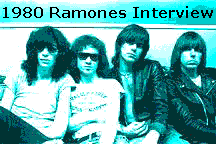
NEW
YORK ( Independent Lens) "They were extraordinary both in the musical
way and in their look. In the days of glam rock they were savage and
extreme and in the days of the long suites they hit them with two
minutes songs. They were a punch in the stomach. The Ramones were the
essence of Rock 'n' Roll." Chris Frantz of Talking Heads. Back in 1974,
something glorious was created in Forest Hills, New York. Anybody wise
enough to take notice during that time will attest to this truth. For
those of us not fortunate enough (or smart enough) to witness first
hand this extraordinary phenomenon, at long last we have access to
photographer Chip Dayton's live and behind the scenes pictures.
Featuring an introduction by friend and rocker
Jesse Malin, The Ramones
is above all else a loving tribute to the band.

After
the release of the The Ramones eponymous debut in 1976, it was evident
that the band would be playing an influential part in defining rock
history. They would soon be sparking the British punk movement in the
'70s; inspiring US hardcore though the '80s and '90s; and now, once
again, their popularity has resurfaced in international garage rock
revivalism.
Jesse Malin wonderfully sums up their unusual sound as a
'rip-your-head off, break-your-heart two-minute blast'. One of the
earliest photographers to work with the band was Chip Dayton, a regular
visitor to the now legendary CBGBs club in New York City, where the
Ramones regularly played to audiences, including the likes of Andy
Warhol,
Debbie Harry and Lou Reed. Dayton's black and white shots
defined the Ramones' appeal as a live band and were featured on their
album 'Road to Ruin'.
His backstage shots provide an even more
revealing look at the band, a strong visual aesthetic that The Ramones
were aware of and keen to promote. As Dayton recalls:
They
looked in the mirror, most definitely. Joey was always fussing with his
hair. He had the longest hair and yeah, was kinda vain, maybe. They
were all always checking their belts and stuff. But the unified look
was a conscious decision. Their little variation was the T-shirts. They
never wore the same T-shirt.
This compelling mix of color and
black & white pictures is a visual treat for any fan. It is also a
curious insight into an era long before
Queer Eye for the Straight Guy
and celebrity clothing lines. The band launched a look that was unknown
and unstyled yet became completely addictive, somehow transforming the
raw immediacy of their music into an image. In doing so, The Ramones
gave millions of kids from around the world the courage to be who they
wanted to be. The recent death of Johnny Ramone has not softened
anybody's admiration for this seminal punk band. The Ramones are one of
those bands that are so important, their influence will shine on
brightly even after most of the members' lives sadly come to an end. In
fact, as a testament to their continued relevance, this spring also
sees the television premiere of "End Of The Century: The Story Of The
Ramones" which will air on PBS April 26, 2005 as Part of Independent
Lens' April
Music Month.
The Ramones, well what more can we say�
"Gabba gabba
We accept you
We accept you
One of us"















 NEW
YORK ( Independent Lens) "They were extraordinary both in the musical
way and in their look. In the days of glam rock they were savage and
extreme and in the days of the long suites they hit them with two
minutes songs. They were a punch in the stomach. The Ramones were the
essence of Rock 'n' Roll." Chris Frantz of Talking Heads. Back in 1974,
something glorious was created in Forest Hills, New York. Anybody wise
enough to take notice during that time will attest to this truth. For
those of us not fortunate enough (or smart enough) to witness first
hand this extraordinary phenomenon, at long last we have access to
photographer Chip Dayton's live and behind the scenes pictures.
Featuring an introduction by friend and rocker
NEW
YORK ( Independent Lens) "They were extraordinary both in the musical
way and in their look. In the days of glam rock they were savage and
extreme and in the days of the long suites they hit them with two
minutes songs. They were a punch in the stomach. The Ramones were the
essence of Rock 'n' Roll." Chris Frantz of Talking Heads. Back in 1974,
something glorious was created in Forest Hills, New York. Anybody wise
enough to take notice during that time will attest to this truth. For
those of us not fortunate enough (or smart enough) to witness first
hand this extraordinary phenomenon, at long last we have access to
photographer Chip Dayton's live and behind the scenes pictures.
Featuring an introduction by friend and rocker 